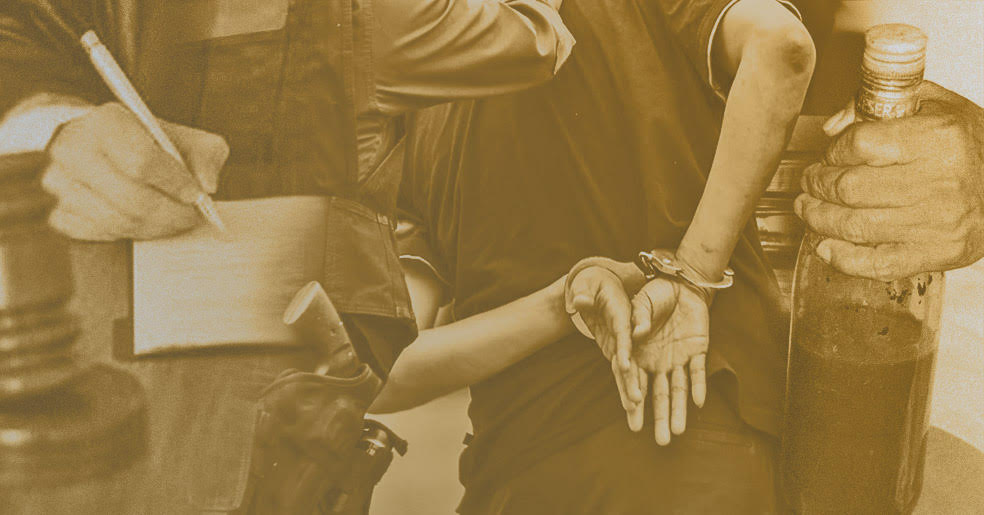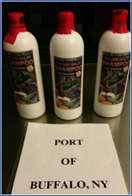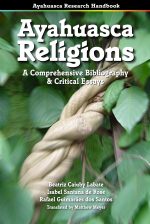That was the beginning of a nightmare for Gustavo Vargas, a 22-year-old Colombian American, who was bringing four ayahuasca bottles in anticipation of his shaman friends
In November 2017, a young man arriving at the Tampa International Airport from Bogota, Colombia was questioned by a security officer about the content of four shampoo bottles neatly packaged in his bag. “Shampoo,” he said. That was the beginning of a nightmare for Gustavo Vargas, a 22-year-old Colombian American, who was bringing four ayahuasca bottles in anticipation of his shaman friends’ visit, scheduled for January 2018. Those ceremonies never occurred, as bottles were confiscated and Vargas charged with importation of DMT, a chemical ingredient in ayahuasca prohibited under the Controlled Substances Act of 1970.
About three months later, in February 2018, Bumper Fisher, a 42-year-old Canadian citizen, unaware of Vargas’s story, anxiously drove from Canada through the border control station in Buffalo, NY. He also carried three shampoo bottles neatly packed under the driver’s seat of his vehicle. The well-trained border officers doing the screening, guided by their instincts, asked Fisher to park his car for routine inspection. Unable to explain the strange brown color and awful smell of the shampoo, he found himself being interviewed by a senior Homeland Security officer in a small private office at the station.
What happened next to Vargas and Fisher should be taken as a clear warning to anyone flirting with the idea of attempting to bring ayahuasca into the USA. The uncanny similarities of both cases are also sending a strong message to the plant medicine community in general.
Tampa International Airport Case
Vargas had already admitted that it was ayahuasca, but he was shocked to watch with his own eyes a color change from a chemical reaction
Gustavo Vargas was detained at the Tampa airport when an officer performed the routine drug test to the liquid in his shampoo bottles in front of him. Vargas had already admitted that it was ayahuasca, but he was shocked to watch with his own eyes a color change from a chemical reaction, meaning that the liquid tested positive for the presence of amphetamines. While he was detained in the airport, the investigation began. Vargas is Colombian-born, with dual citizenship, and a resident of Tampa. He was working for a janitorial services company, and, like many other immigrants, pursuing the American dream. His transit history indicated that was his fourth trip to Colombia in 2017, and he admitted that these trips were paid for by his friends in Colombia because he did not have the financial resources. Unfortunately, Vargas’ circumstances were pointing towards the classic definition of a “mule,” or carrier of illegal drugs. However, he claimed to belong to an indigenous community in Colombia and showed an ID card to prove it. He subsequently obtained additional documentation that was eventually filed into his court case proving he was authorized to carry plant medicines. Vargas spent the night in a jail cell and the next day was released with a $25,000 bond and an electronic monitor attached to his right ankle.
After six months of tense uncertainty, in May 2018, Vargas was formally charged with possession of DMT. Surprisingly, the accusation omitted the fact that he was detained with 11 kilograms of ayahuasca. It is well known that frequently drug possession suspects are charged with the full weight of the seized material. As an example: one gram of cocaine mixed into one pound of sugar can be considered one pound of cocaine for prosecution purposes. Technically, Vargas was liable to a charge of possession of 11 kilograms of DMT, although ayahuasca contains only around one percent DMT. Such a substantial amount of DMT would have caused Vargas to spend many years in prison; however, the official document read, “a mixture containing a detectable amount of DMT.” That was a favorable twist in the case for Vargas, as his offense was classified as a misdemeanor and not as a felony. To explain such leniency, we can only speculate that the investigation concluded that Vargas was not a drug dealer in the traditional criminal sense, and that ayahuasca was not considered very harmful to society.
The public defender assigned to the case assisted Vargas in pleading guilty of the possession charge in June 2018, and his electronic monitor was removed that same day. Later, in October, he was sentenced to one year of probation without incarceration and 100 hours of community service. Another sign of leniency was shown by the sentencing judge who waived the mandatory fine for Vargas, which could have been from $200 up to $9,500, in accordance with current statues.
Canada-USA Border Case
Let’s move to Canada now. Bumper Fisher is a Canadian citizen who agreed to help some friends by bringing them three bottles of ayahuasca from Canada to Ithaca, New York, where a visiting shaman was expected to show up for a series of ayahuasca ceremonies. On the cold winter Thursday night of February 8, 2018, around 10:30 p.m., while driving his 2003 Ford Focus, Fisher presented his Canadian passport to the US Customs & Border Protection officer at the Peace Bridge Niagara Falls crossing. He said he was crossing to visit some friends, but when asked a follow up question, he could not clearly explain how he knew these friends. Since records showed him crossing the border only once before in 2017, he was pulled over for routine inspection.
Three bottles of shampoo were found concealed under the driver’s seat and covered by a pile of blankets
Three bottles of shampoo were found concealed under the driver’s seat and covered by a pile of blankets. For one hour, Fisher tried to explain that this liquid was a natural substance, but when they realized it contained DMT, they referred him to a Homeland Security agent who arrived around 2:00 a.m. to interview him. It was a long session in which Fisher very truthfully explained every single detail about what he knew about the ayahuasca, the ceremonies, the people involved, etc. The agent was very concerned about the monetary aspect, such as how much profit it would generate when sold. He went over one year of emails in his iPad and text messages in his mobile phone, but nothing compromising was found. After doing a few internet searches to learn about ceremonies and the other ayahuasca information provided by Fisher, the officer was convinced Fisher was not a drug dealer. Fisher felt hopeful for a brief moment, yet what happened next was not only perplexing but also cast a bit of suspicion on his motives. The Homeland Security (HS) agent called the Buffalo Police Department to pick Fisher up. Apparently, he didn’t want an ayahuasca case processed in the US federal court system. He basically dumped Fisher into New York State jurisdiction for booking and processing.
Looking from the outside, it seems that the federal system, for unknown reasons, did not want to prosecute a case of ayahuasca and establish a precedent, negative or positive.
Fisher was booked into custody at the Buffalo police station on Friday night. They didn’t know what to do with him because he was Canadian and decided to send him to Erie County Detention Center, where he stayed for five days without getting charged. On Wednesday, HS officers processed him for deportation and released him to his family under a $20,000 bail, conditional on his return to Buffalo for trial. A few days later, lab tests of the “shampoo” were taking longer than expected, and they rushed to trial to comply with the mandatory judicial timetable. At the trial, the judge suggested a sentence of six months in jail. Surprisingly, the state prosecutor, not the lawyer of defendant, intervened and asked the judge to remove all references to DMT in the court file and only impose a monetary fine for a charge of simple drug possession as Fisher was already being deported. The judge agreed, and the case was closed and archived on the spot. Everyone was surprised about how fast the events unfolded that morning. Fisher speculated that the HS officer and the state prosecutor somehow had an earlier conversation about his case, after which the prosecutor decided to act. Looking from the outside, it seems that the federal system, for unknown reasons, did not want to prosecute a case of ayahuasca and establish a precedent, negative or positive. At that time, they were unaware of the fact that Gustavo Vargas was already under federal investigation in Florida for the same offense.
After partially recovering from such an emotionally intense morning, Fisher decided to drive with his family directly back to Canada and forget all about the administrative process needed to recover his 2003 Ford Focus. After all, leaving his vehicle behind was significant to him, considering its negligible market value and the unpleasant memories now attached to it. Fisher never looked back, and he is currently enjoying his normal life in Canada.
Some Lessons Learned
We have learned, in this case, that ayahuasca has tested positive for illegal amphetamines (a “false positive”), and this requires further explanation
One important lesson learned here has to do with the chemical drug testing when applied to ayahuasca. It is now a well-established fact that, contrary to popular belief, ayahuasca tests positive for illegal substances when tested with standard drug testing chemicals. These tests work with chemical reagents that are designed to change color when exposed to the target illegal substance. We have learned, in this case, that ayahuasca has tested positive for illegal amphetamines (a “false positive”), and this requires further explanation. Although the chemical reagents of the test don’t react with the dramatic color change expected for actual amphetamines, the truth is that they show a slight subtle color reaction, indicating that ayahuasca is not totally inert to the test. This is enough reason for any inspecting officer to make a lawful detention of the suspect and file charges for drug possession. The chemical reasons for this phenomenon are not well understood, but the fact remains that it is true. That is question that needs to be asked of the experts in ayahuasca biochemistry and further researched.
Law enforcement has shown relative leniency so far, because first, we can speculate they know that ayahuasca is not addictive and relatively harmless
Anyone transporting ayahuasca must know that attempting to avoid detection with bottles or labels of known consumer products may flag you as a smuggler. Fortunately, both Vargas and Fisher were able to address the major concerns of the law enforcement officers they encountered. Basically, their true identities and criminal backgrounds were clean, their potential role in a bigger criminal organization was not found, nor their evident intent to distribute for profit. They both passed all these key concerns except one: The shampoo bottles were evidence of intent to avoid detection, raising the red flag for the officers; lying when asked about these complicated matters even more. They were lucky under such circumstances, as ayahuasca doesn’t seem to be a priority target of drug enforcement policies, despite its illegal status due to its DMT content. Under a strictly enforced scenario, they would have received severe jail sentences of not less than five years. Law enforcement has shown relative leniency so far, because first, we can speculate they know that ayahuasca is not addictive and relatively harmless; second, they know that the ayahuasca movement is generally composed of well-intended people seeking healing and knowledge, not criminal types; and third, the positive outcomes of the religious freedom cases involving the UDV and the Santo Daime cases might show that a full prosecution might be challenging.
Well-intended supporters and insiders of the ayahuasca community that want to contribute to the expansion of consciousness in the world often volunteer to assist shamans in any way they can. This was the case of Vargas, who offered to help by transporting ayahuasca from Colombia for the forthcoming ceremonies of a Colombian shaman in Florida. Similarly, Fisher attempted to transport ayahuasca from Canada to Ithaca, New York to help another visiting shaman. These two cases should serve as a cry of warning to those naïve souls who assume the huge legal risks that should perhaps be backed up by a previous plan, and the existence of a community. We need to raise awareness in the plant medicine communities nationwide about these risks.
Both cases were treated as misdemeanor offenses, despite the amount of ayahuasca seized, and both were released without incarceration.
Until now, we were not aware of any criminal conviction for ayahuasca transportation in the history of the USA. This all changed when in less than three months, two cases were filed and successfully prosecuted. Vargas and Fisher had relatively modest occupations (Vargas was a janitor, Fisher was a metal welder), and were carrying ayahuasca in shampoo bottles. Both cases were treated as misdemeanor offenses, despite the amount of ayahuasca seized, and both were released without incarceration. They were lucky because it could have been worse. However, it wasn’t easy for either of them. Vargas spent 10 months of agonizing uncertainty, potentially facing years in jail while wearing an embarrassing and uncomfortable ankle bracelet. He now will have to do one year of weekly parole reporting, with periodic drug testing, and will not be able to travel beyond a limited radius around the Tampa area. Fisher, on the other hand, estimates he lost about $7,000 between fines, expenses, and his abandoned car; but the most painful of all was the lifetime ban on returning to the USA, something that he was expecting to continue enjoying frequently. As first offenders, they both will remain tainted with a criminal case on their previously clean records. While these have been hard lessons for Vargas and Fisher, We hope they become easy lessons to learn for the rest of us in the plant medicine communities.
Gustavo Vargas News
He called it a hair tonic, feds called it illegal, but the name is ‘ayahuasca’. Tampa Bay Times, 2018.
Probation ordered for Tampa man who brought South American spiritual ‘tea’ to airport. Tampa Bay Times, 2018.
Bumper Fisher News
CBP Seizes Hallucinogenic Drug Hidden In Shampoo Bottles. U.S. Customs and Border Protection, 2018.
Hallucinogenic drug found in shampoo bottles at Peace Bridge. WIVB 4, 2018.
Global Library of legal cases on ayahuasca
US Legality Psychoactive-Using Churches under RFRA
For further information, contact Chacruna’s Council for the Protection of Sacred Plants: [email protected]
Take a minute to browse our stock:
Did you enjoy reading this article?
Please support Chacruna's work by donating to us. We are an independent organization and we offer free education and advocacy for psychedelic plant medicines. We are a team of dedicated volunteers!
Can you help Chacruna advance cultural understanding around these substances?












